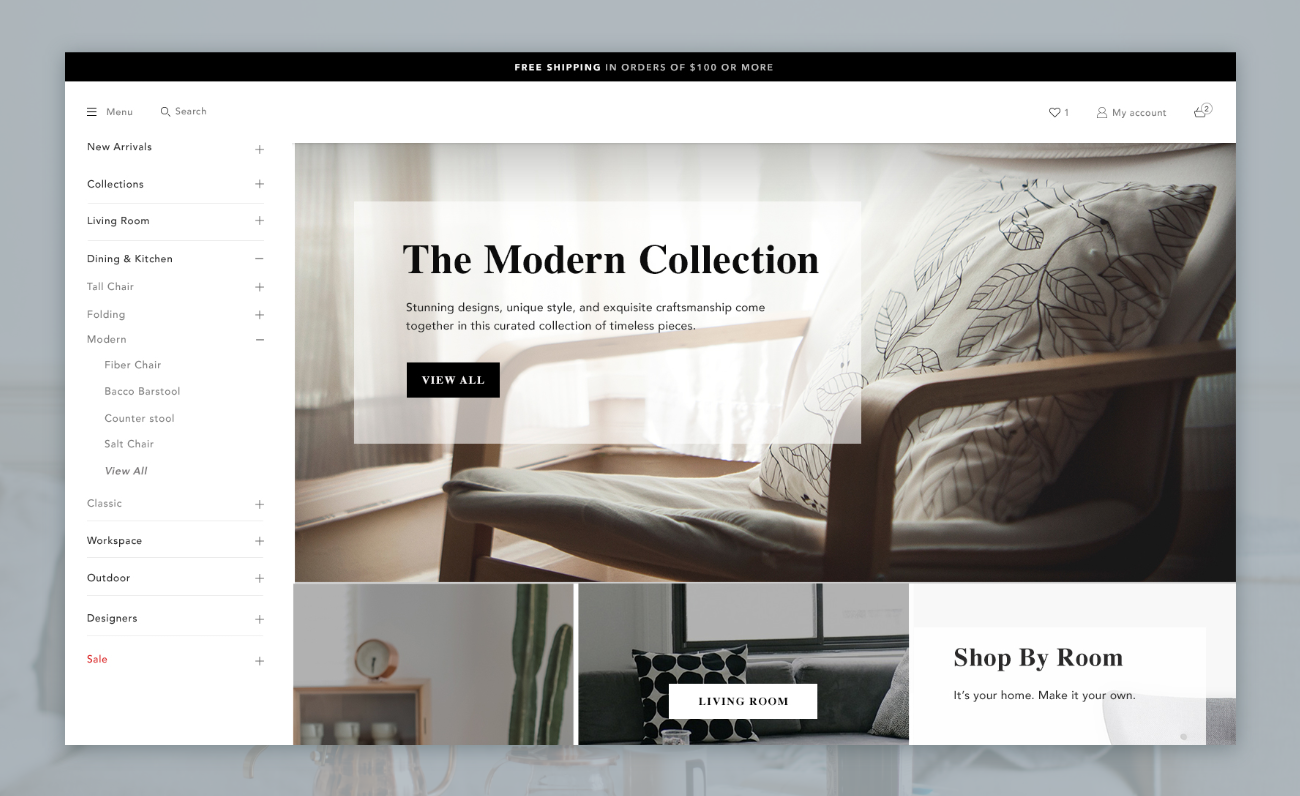By Miva | November 4, 2019

See why top ecommerce brands use Miva’s no-code platform to run
multiple stores, manage massive catalogs, and grow their revenue.
Buying furniture and home decor online is becoming increasingly popular, with ecommerce sales for the furniture and home furnishings market expected to reach almost $100 billion by 2022.
Although buyers are warming up to the idea of buying their furniture on a website, reports show that the majority of customers still prefer physical retail experiences. Shoppers value the in-person evaluation of the size, color, and overall “feel” of home furnishing products before making a purchase decision. This experience doesn’t always translate to an online store.
In this article, we’ll cover how you can recreate that “look and feel” experience of brick-and-mortar shopping and deliver an engaging (and profitable) home decor experience online.
When shoppers explore home decor products in a showroom, they often look at more than just the product category. Shoppers consider tangible traits like color, pattern, style, and texture when evaluating products—traits that are often not adequately showcased on a website.
Home decor merchants can encourage product discovery and increase order value with a guided browsing experience centered on the product qualities shoppers care about. A shopper gravitating toward a table’s color and shape might like how it fits with similar decor pieces and decide to purchase the complete set.
To satisfy the desire for a tactile shopping experience, your site must go beyond providing product images. Consider your customers’ interests and strategize how you can improve their search. Giving shoppers the ability to search by trends, styles, color, collections, and “frequently bought together” products encourages them to explore more of your product catalog, increasing the chance of conversion.
One significant advantage enjoyed by brick-and-mortar decor and furniture stores is that customers can directly “try out” a product. They can see how the item fits in a physical space, try pairing it with similar or complementary items, and determine whether it matches their personal vision and taste.
How can you bring this experience online? Consider incorporating product visualizers that allow shoppers to do things like view products in different colors, test pieces in different settings, and plan their room layouts. Window film retailer Decorative Films achieves this with a custom visualizer that helps clients see their window treatments in a variety of real-world environments. The tool has been one of many clever site improvements that has helped to boost the retailer’s average order value by 84 percent.
Despite the absence of a physical showroom, online home decor sellers have the opportunity to surpass physical stores with an experience that engages customers, takes them beyond the confines of a showroom, and allows them to discover products from the comfort of home.
When it comes to home decor, personal taste plays a big role in the purchasing decision. From the design of the products to the exact materials used in their creation, some customers want personalized choices that feel tailor-made for their homes.
A seller that allows their customers to customize the material, design, color, and size of their products will better grab buyer interest and encourage repeat purchases. Supplement this degree of personalization with rich media graphics, lifestyle photos and videos, and exclusive behind-the-scenes content to get customers to quickly notice and connect with your brand.

Furniture and housewares are often considered investment products that aren’t purchased on a regular basis. Because customer opinions on products can change once those products are actually placed in their homes, the decor market often sees a higher return rate than others.
To compete with physical stores, online home decor retailers need to generate trust online. A solid return and exchange policy, assembly services (both DIY and paid), and financing options helps to both instill confidence in the customer and increase their buying capacity.
Collecting and leveraging user-generated content is another effective way to encourage loyalty. Allow customers to create their own “stylist” profiles where they can show off their purchases, bookmark decor ideas, and provide social proof and reviews. This helps other customers get a sense that they are not the only one considering this home decor website for their requirements—there is a community of shoppers who are enthusiastic about the brand.

When it comes to the home decor and furniture market, customers value the interactivity they experience in a physical store. For your online home decor store to succeed, building consumer engagement should be your top priority. Shoppers seek retail experiences that are bespoke, immersive, personalized, and flexible and will give their loyalty to brands that support their buying journey.
Although the absence of a physical showroom can create a barrier, with the right tools online retailers can deliver a best-in-class experience that drives home the “look and feel” and reaffirms their customers’ decision to shop online.
Love it? Share it!
No worries, download the PDF version now and enjoy your reading later...
Download PDF Miva
Miva
Miva offers a flexible and adaptable ecommerce platform that evolves with businesses and allows them to drive sales, maximize average order value, cut overhead costs, and increase revenue. Miva has been helping businesses realize their ecommerce potential for over 20 years and empowering retail, wholesale, and direct-to-consumer sellers across all industries to transform their business through ecommerce.
Visit Website